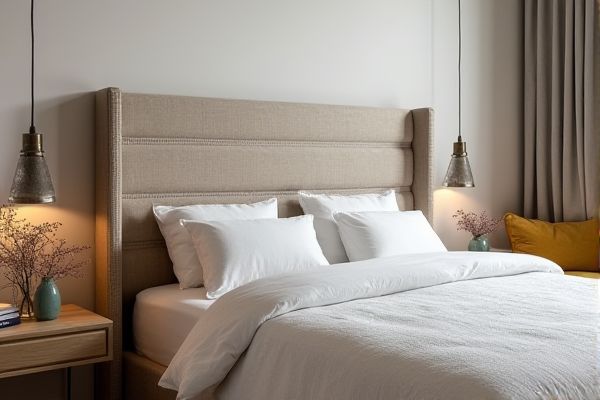
Choosing between a headboard and a footboard depends on your bedroom style and functionality needs, as headboards provide support and create a focal point while footboards can add a decorative touch or help keep bedding in place. Explore the rest of the article to discover which option best suits Your bedroom and enhances comfort and design.
Table of Comparison
| Feature | Headboard | Footboard |
|---|---|---|
| Location | Top end of the bed, behind the sleeper's head | Bottom end of the bed, near the sleeper's feet |
| Primary Purpose | Provides back support, aesthetic appeal, and prevents pillows from falling | Keeps bedding in place, adds decorative detail |
| Design Impact | Focal point of bedroom decor | Subtle design feature complementing bed style |
| Material Options | Wood, metal, upholstered, or mixed materials | Usually matches headboard material |
| Functional Uses | Supports sitting up in bed | Prevents blankets and sheets from sliding |
| Common Sizes | Varies with bed size: Twin to California King | Corresponds to bed frame dimensions |
| Installation | Positioned against the wall; attached to frame or wall-mounted | Attached to bed frame's foot end |
| Maintenance | Regular dusting and cleaning depending on material | Similar to headboard; easier to clean due to lower height |
What is a Headboard?
A headboard is a vertical panel attached to the head of a bed, providing support and enhancing the bed's aesthetic appeal. It serves as a backrest for sitting up in bed and can offer insulation from cold walls, improving comfort. Your choice of headboard material and design impacts both the bedroom's style and the overall sleep experience.
What is a Footboard?
A footboard is the vertical panel found at the end of a bed frame, opposite the headboard, designed to provide structural support and enhance the bed's aesthetic appeal. It helps keep your mattress and bedding in place, preventing them from sliding off the bed corners. Footboards come in various styles and materials, allowing you to customize your bedroom's look while ensuring durability and comfort.
Headboard vs Footboard: Key Differences
The headboard, positioned at the head of the bed, primarily provides support for sitting up and enhances bedroom aesthetics, while the footboard, located at the foot of the bed, serves to contain the mattress and prevent bedding from slipping. Headboards often feature decorative designs and materials, contributing to the room's style, whereas footboards tend to be simpler and more functional. Size, height, and design variations between headboards and footboards impact both comfort and visual balance in bedroom furniture.
Design and Style Considerations
Headboards often serve as a focal point in bedroom design, offering opportunities for bold colors, intricate patterns, or upholstered textures that enhance Your room's aesthetic. Footboards typically have a subtler design, adding structural balance without overwhelming the space, and they can complement the headboard's style through matching materials or finishes. Choosing between a headboard and footboard depends on Your desired visual impact and how much emphasis you want to place on the bed as a design element.
Functional Benefits of Headboards
Headboards provide essential support for sitting up in bed, offering a comfortable backrest for reading or watching television. They also protect your wall from scratches and stains, maintaining the cleanliness and condition of your bedroom. By adding a headboard, you can enhance the aesthetic appeal of your bed while improving its overall functionality.
Practical Uses of Footboards
Footboards provide practical benefits by preventing bedding from slipping off the end of the bed, maintaining a neat and secure sleeping area. They can also serve as a structural element that adds stability to the bed frame, enhancing overall durability. Furthermore, footboards offer a convenient spot to sit while dressing or to place items such as blankets or pillows.
Space and Room Layout Implications
Headboards typically require more wall space and influence room layout by anchoring the bed against a wall, creating a defined focal point and allowing for bedside tables. Footboards extend the bed's footprint, reducing usable floor space and potentially limiting storage options like under-bed drawers or space for benches. Choosing between headboard and footboard depends on room size, desired aesthetic, and functional space optimization.
Comfort and Support Comparison
Headboards provide essential comfort by offering a cushioned surface for you to lean against while sitting up in bed, improving posture and reducing back strain. Footboards, while less common for support, can enhance stability by preventing bedding from sliding off and offering a subtle boundary that supports your feet at the bed's end. Choosing between them depends on whether your priority is ergonomic back support or subtle foot positioning during rest.
Choosing the Right Option for Your Bed
Selecting between a headboard and footboard depends on both aesthetic preferences and functional needs; headboards offer support for sitting up and add visual height, while footboards provide a finishing touch and prevent bedding from slipping. Consider mattress size compatibility, bedroom space limitations, and style cohesion with existing furniture to ensure the chosen option complements the overall design. Materials like wood, metal, or upholstered fabric influence durability and comfort, making them crucial factors in the final decision.
Headboard vs Footboard: Which is Better for You?
Choosing between a headboard and footboard depends on your bedroom space and style preferences. Headboards provide back support and serve as a focal point for bedroom design, while footboards can add a traditional look and help keep bedding in place. Your decision should consider comfort, aesthetic appeal, and how each element complements your overall bedroom layout.
 homyna.com
homyna.com